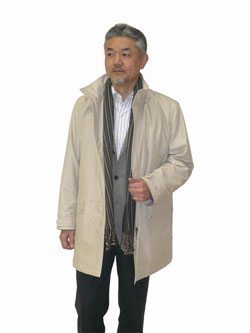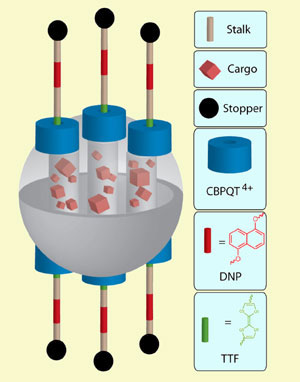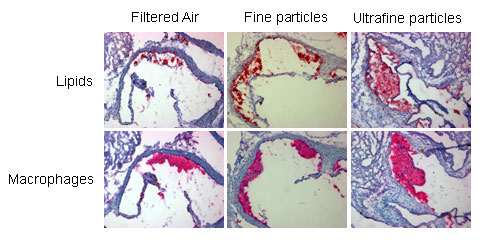Rio Tinto Alcan reinforced its commitment to community involvement today with a $1-million donation to the 'Thinking Ahead Campaign' at the Montreal Neurological Institute and Hospital (MNI), affiliated with McGill University and the McGill University Health Centre.
Jan 18th, 2008
Read more
 Apparel manufacturer Sanyo Shokai has released the first in a series of men's coats which are pollen-resistant. They're made from a fabric developed by Toray that's produced in a nanotechnology process that repels water and pollen.
Apparel manufacturer Sanyo Shokai has released the first in a series of men's coats which are pollen-resistant. They're made from a fabric developed by Toray that's produced in a nanotechnology process that repels water and pollen.
Jan 18th, 2008
Read more
The tiny copper wires that connect different areas of an integrated circuit may soon limit microchip-processing speeds. So European researchers have developed technologies to produce and combine semiconductor microlasers with silicon wave guides for novel, power-efficient optical connections.
Jan 18th, 2008
Read more
Will graphene really take the semiconductor industry towards the 'Beyond CMOS' era? Some answers to this key question are sought through experiment and simulation in a European research project on Graphene-based Nanoelectronic Devices called GRAND. The project starts January 1st, 2008 and is coordinated by Nanotechnology specialist AMO GmbH in Aachen, Germany.
Jan 18th, 2008
Read more
Micronit Microfluidics b.v. and IVAM Microtechnology Network are organizing an Open Business Meeting on February 21 in Enschede, the Netherlands. Leading institutes such as IMTEK and Mesa+ and the companies Micronit Microfluidics, Medimate, Boehringer Ingelheim microParts, and Bartels Mikrotechnik will present current trends and developments of micro fluidics for life sciences and medical devices.
Jan 18th, 2008
Read more
A guide to the Safe Handling of Nanomaterials, drawn up by the SAFENANO team under BSI Committee NTI/1, Nanotechnologies, has this week been published by BSI British Standards.
Jan 18th, 2008
Read more
Somenath Mitra, along with researchers at the New Jersey Institute of Technology (NJIT), has developed a potentially cheap solar technology which can be painted or printed on flexible plastic sheets. The benefits could be enormous to the consumer, producer, and the environment.
Jan 18th, 2008
Read more
 Scientists at the University of California-Los Angeles (UCLA) have signed a deal with a private investment firm to develop and market 'nanomachines' to treat cancer. The mechanised nanoparticles include tiny valves and impellers to help release chemotherapy drugs exactly where they are needed - reducing their side-effects and boosting the effectiveness of the treatments.
Scientists at the University of California-Los Angeles (UCLA) have signed a deal with a private investment firm to develop and market 'nanomachines' to treat cancer. The mechanised nanoparticles include tiny valves and impellers to help release chemotherapy drugs exactly where they are needed - reducing their side-effects and boosting the effectiveness of the treatments.
Jan 18th, 2008
Read more
Scientific studies on climate change, energy and alternative fuels are among the 30 projects awarded more than 145 million processing hours on supercomputers at Oak Ridge National Laboratory through the Department of Energy's Innovative and Novel Computational Impact on Theory and Experiment (INCITE) program.
Jan 17th, 2008
Read more
 Patients prone to heart disease may one day be told by physicians to avoid not only fatty foods and smoking but air pollution too. A new academic study led by UCLA researchers has revealed that the smallest particles from vehicle emissions may be the most damaging components of air pollution in triggering plaque buildup in the arteries, which can lead to heart attack and stroke.
Patients prone to heart disease may one day be told by physicians to avoid not only fatty foods and smoking but air pollution too. A new academic study led by UCLA researchers has revealed that the smallest particles from vehicle emissions may be the most damaging components of air pollution in triggering plaque buildup in the arteries, which can lead to heart attack and stroke.
Jan 17th, 2008
Read more
Health 2.0 Northeast kicks-off event series on Jan. 23rd in Cambridge with Healthcare, Web 2.0 and social networking leaders.
Jan 17th, 2008
Read more
On Tuesday, January 22, 2008 at 2:00 pm. in SD-366, the Congressional Nanotechnology Caucus will host a briefing entitled: 'Nanotechnology and Innovation, Commercialization, and Prize Competitions.'
Jan 17th, 2008
Read more
According to a report published today by NorTech and the Nano-Network, Ohio exhibits significant strengths in nanotechnology research, development, commercialization and entrepreneurship; and Northeast Ohio, in particular, is a leader in nanotech innovation. Through better cross-pollination of Ohio's regions and sectors, the State has the potential to become an even greater national player in nanotechnology.
Jan 17th, 2008
Read more
Movie characters from the Terminator to the Bionic Woman use bionic eyes to zoom in on far-off scenes, have useful facts pop into their field of view, or create virtual crosshairs. Off the screen, virtual displays have been proposed for more practical purposes - visual aids to help vision-impaired people, holographic driving control panels and even as a way to surf the Web on the go.
Jan 17th, 2008
Read more
Scientists have used new optical technologies to observe interactions in nanoscale systems that Heisenberg's uncertainty principle usually would prohibit.
Jan 17th, 2008
Read more
Science fiction author Kathleen Ann Goonan was writing about nanotechnology before most people even know it existed. Her Nanotech Quartet, including her celebrated first novel Queen City Jazz, is about a future United States where nanotech has gone wild and turned cities into living entities - and reprogrammed people to reenact scenarios from US history and literature.
Jan 17th, 2008
Read more




 Subscribe to our Nanotechnology News feed
Subscribe to our Nanotechnology News feed